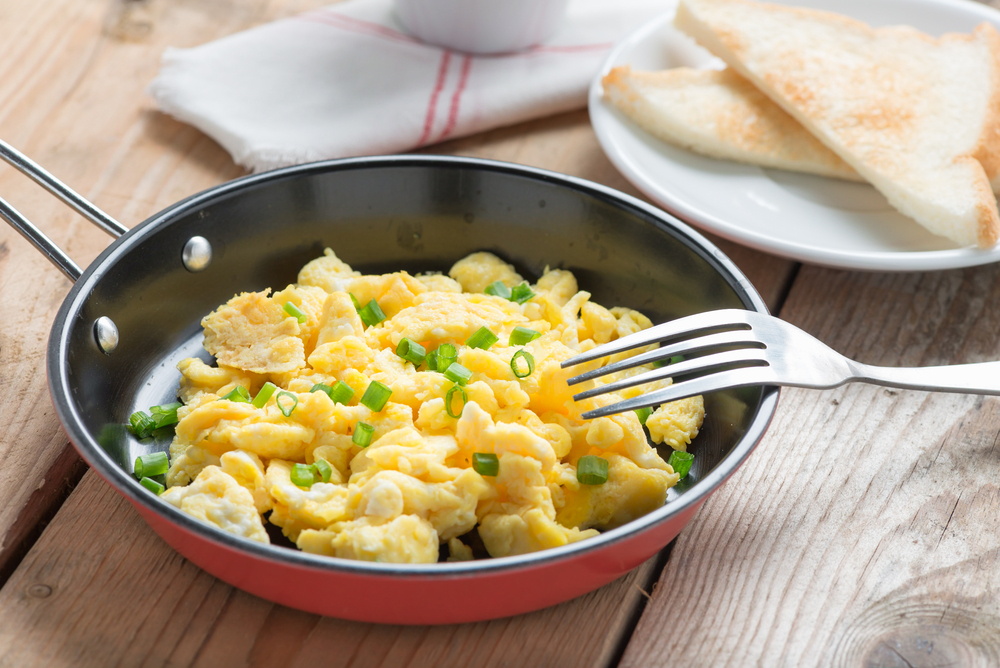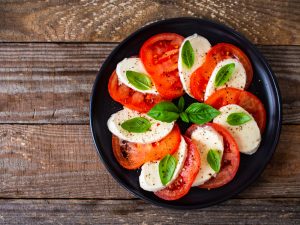Scrambled eggs can be part of a healthy weight-loss plan because they’re high in protein, help you feel full, and can reduce how much you eat later — but the benefits only show up if your overall calories stay in check.
Keep reading for the research, calorie math, and practical tips to make scrambled eggs work for you.
The Quick Verdict on Scrambled Eggs and Weight Loss
Scrambled eggs can support weight loss when you manage calories and control what goes in the pan.
Their protein keeps you full, helps steady appetite, and can reduce how much you eat later—just don’t expect them to burn fat on their own.
Why They Help
Eggs are naturally protein-dense for the calories, and that’s useful at breakfast when hunger can set the tone for the day.
Trials comparing egg breakfasts with calorie-matched grain breakfasts show higher satiety and lower intake at the next meal—and sometimes across 24 hours—likely thanks to steadier glucose/insulin and a blunted ghrelin (hunger hormone) response.
In practice, targeting about 25–35 g of protein in the morning works best for appetite control.
Eggs make that target easy: each large whole egg has ~6 g of protein, and each large egg white adds ~3.6 g for only ~17 kcal, so combinations like 3 whole eggs + 2 whites or 2 whole eggs + 4–5 whites get you into the sweet spot without pushing calories too high.
Not a Fat Burner: Context Matters
Eggs don’t cause fat loss in isolation.
In an 8-week randomized trial in people with overweight/obesity, an egg breakfast enhanced weight loss only when participants were already on a calorie-restricted diet; there was no benefit under free-living, non-dieting conditions.
A separate 6-month trial under energy restriction found no difference in weight loss between egg and cereal breakfasts—both groups lost meaningful weight because total calories were controlled.
Translation: eggs help you stick to a deficit; they don’t replace it.
Cooking Method: Where Calories Hide
Scrambling isn’t “bad,” but it often invites add-ins that push energy up.
A large scrambled egg is ~91 kcal (~6 g protein) versus ~78 kcal for a large hard-boiled egg with the same protein.
The gap widens in the pan: oil adds ~119 kcal per tablespoon (~40 per teaspoon), butter adds ~102 kcal per tablespoon, and whole milk adds ~9 kcal per tablespoon.
For example, two scrambled eggs cooked with 1 teaspoon of oil and 2 tablespoons of milk land around 240 kcal (≈182 from eggs + 40 oil + ~18 milk), while two hard-boiled eggs are ~156 kcal.
The lesson is simple: measure pan fat, or use a nonstick skillet and keep added fat to ½–1 teaspoon, or try a steam/water scramble (add 1–2 tablespoons water to beaten eggs and cook low and slow) to save 20–80 kcal.
How to Make Your Scramble Work for Weight Loss
Start with protein, then control calories with precise cooking and smart add-ins.
Build toward 25–35 g protein using whole eggs plus whites (for example, 3 whole + 2 whites or 2 whole + 4–5 whites).
Keep pan calories honest—don’t eyeball oil or butter—and consider nonstick or a water scramble when you want to save energy without sacrificing texture.
Volumize with low-calorie vegetables such as spinach, tomatoes, peppers, mushrooms, or zucchini to add bulk and fiber (eggs themselves have virtually no fiber), and season with herbs, spices, salsa, or hot sauce instead of heavy cheese and cream unless you’ve budgeted for them.
Many people do well with a 300–450 kcal breakfast; adjust up or down to fit your daily target and activity.
What the Research Really Shows
Here’s the short story from solid studies: egg breakfasts tend to keep you fuller than grain-based ones of the same calories, but weight loss only improves when your total intake is kept in a deficit.
Randomized crossover trials that compared egg breakfasts with grain-based breakfasts at equal calories consistently found higher satiety and lower intake at the next meal, and in some cases across 24 hours.
The most likely reasons are steadier glucose and insulin responses after eating eggs and a blunted rise in ghrelin, the hormone that drives hunger. In plain terms, eggs help smooth out the post-breakfast appetite rollercoaster.
When you look at fat loss, context decides the outcome.
In an 8‑week randomized trial with adults who had overweight or obesity, an egg breakfast improved weight loss versus a bagel breakfast only when participants were already following a calorie‑restricted plan; there was no advantage in free‑living, non‑dieting conditions.
A separate 6‑month trial conducted under energy restriction found no difference in weight loss between an egg breakfast and a cereal breakfast—both groups lost meaningful weight because calories were controlled.
What this means for you: eggs are a useful tool, not a shortcut.
They can make a calorie deficit easier to stick to by curbing hunger, yet they don’t create that deficit on their own.
If you like eggs, use them to hit a higher‑protein breakfast target and pair that with a clear daily calorie plan; that’s where the research-backed benefits show up.
The Protein Advantage at Breakfast
Protein at breakfast does more than pad your macros—it steadies hunger so you eat less later.
The sweet spot most often linked to better appetite control lands around 25–35 grams, and eggs make that easy without much prep.
A standard large whole egg gives you about 6 grams of protein.
That means two eggs alone (~12 grams) usually won’t hit the range that shows up in studies.
This is where egg whites shine: each large white adds roughly 3.6 grams of protein for about 17 calories, so you can raise protein without piling on energy.
For most people, a target near 30 grams works well on busy mornings because it blunts mid-morning cravings and keeps lunch portions reasonable.
To make the numbers work, think in simple building blocks that you can rotate without changing your routine.
Three whole eggs plus two whites totals about 25 grams and fits the lower end of the target if your overall breakfast is already substantial.
If you run hungrier or want more staying power, go with two whole eggs plus four to five whites (about 26–30 grams), which pushes protein up while keeping calories moderate.
Another lean option is one whole egg plus six whites (about 28 grams) when you want the flavor and nutrients of the yolk with extra protein from whites.
These patterns scale cleanly whether you cook on the stove, bake egg “muffins,” or do a quick microwave scramble at the office.
Convenience is the real advantage here. Eggs cook in minutes, need only a pan and a fork, and don’t require marinating, long cook times, or complicated cleanup.
If separating whites slows you down, keep a carton of liquid egg whites in the fridge for quick measuring.
From there, you can adjust to your day: add a cup or two of low-calorie vegetables for volume and fiber, keep added fats measured so calories stay predictable, and season with herbs, salsa, or hot sauce.
The result is a breakfast that reliably hits the 25–35 gram range, keeps you satisfied, and supports a calorie deficit without feeling like a chore.
Cooking Methods and the Calorie Math

Scrambling isn’t the issue; hidden extras are.
The way you cook—and what you add—decides whether your eggs stay light or drift higher in calories.
A large scrambled egg is about ~91 kcal with ~6 g protein, while a large hard-boiled egg is ~78 kcal with the same ~6 g protein.
That small base difference isn’t the problem; it’s the pan. Oil adds ~119 kcal per tablespoon (~40 per teaspoon), butter adds ~102 kcal per tablespoon, and whole milk adds ~9 kcal per tablespoon.
Put it together and you can see how fast things climb: two scrambled eggs with 1 teaspoon oil and 2 tablespoons milk land around ~240 kcal (≈182 from eggs + 40 oil + ~18 milk), whereas two hard-boiled eggs are ~156 kcal.
The fix is precision.
Measure fats instead of eyeballing, since a “quick pour” or “small knob” can easily sneak in 40–120+ kcal without adding much food volume.
If you like a soft, creamy scramble, you don’t have to give that up.
Use a nonstick pan and keep oil to ½–1 teaspoon, or switch to a water/steam scramble by adding 1–2 tablespoons of water to beaten eggs and cooking low and slow; both approaches save 20–80 kcal compared with a casual swirl of oil.
Skip milk entirely or cap it at a tablespoon if you prefer a looser texture.
Fold in low-calorie vegetables such as spinach, tomatoes, peppers, mushrooms, or zucchini for bulk and fiber with very little energy cost, and lean on herbs, spices, salsa, or hot sauce for flavor rather than cheese or cream unless you’ve planned for them.
A few simple habits keep your numbers honest without slowing you down: keep a measuring teaspoon by the stove; use a silicone brush or an oil mister to coat the pan lightly and evenly; weigh butter when possible so “a pat” doesn’t become a tablespoon; and avoid topping off the pan mid-cook.
With those in place, scrambled eggs stay predictable in calories and still deliver the protein and satisfaction you’re after.
Building a Weight-Loss-Friendly Scramble
Think of your scramble as a protein-first base with measured fat and smart volume.
Small tweaks in the pan and on the plate keep calories predictable while hunger stays in check.
Start with a template that hits satiety without blowing your budget.
Use a nonstick skillet and measure fat—½–1 teaspoon of oil is usually enough—or go with a water/steam scramble by whisking in 1–2 tablespoons of water and cooking low and slow.
That single choice can save roughly 20–80 kcal compared with a casual pour.
Build protein to the 25–35 g range using whole eggs plus whites, then fold in low-cal vegetables such as spinach, peppers, mushrooms, or zucchini for bulk and fiber.
Season hard with herbs, spices, salsa, or hot sauce so you don’t feel the need for cream or heavy cheese unless you’ve planned for them.
As a simple guardrail, keep breakfast in the 300–450 kcal window for most days and adjust up or down to match your total daily target and activity.
A few habits make this easy to repeat. Keep a teaspoon by the stove so oil stays honest.
If you like a richer texture, allocate the calories on purpose—perhaps ½ teaspoon oil in the pan and a tablespoon of salsa on top instead of cream.
Pre-chop a container of mixed vegetables so the “volume and fiber” step is grab-and-go.
Liquid egg whites are handy when you want extra protein without much energy; each large egg white adds ~3.6 g protein for ~17 kcal, and two to five whites slot in smoothly alongside whole eggs.
Plate with intent: if your scramble is on the lower end of the calorie range, add fruit or an extra cup of vegetables rather than more fat so fullness comes from volume, protein, and fiber.
Three example builds (approximate macros):
- Lean veggie scramble (~330–360 kcal, ~26 g protein): 3 whole eggs + 2 egg whites, cooked on nonstick with ½ tsp oil; fold in ~2 cups mixed veg (spinach, peppers, mushrooms); top with salsa. (Eggs ≈ 307 kcal, whites 34 kcal, oil 20 kcal, veg ~20–30 kcal.)
- High-protein, lower-fat scramble (~340–370 kcal, ~26–27 g protein): 2 whole eggs + 4 egg whites, 1 tsp oil, big handful of zucchini/onion; herbs to finish. (Eggs ≈ 182 kcal, whites 68 kcal, oil 40 kcal, veg ~30–40 kcal.)
- Avocado & pico scramble (~360–390 kcal, ~26–27 g protein): 2 whole eggs + 4 egg whites, ½ tsp oil, tomatoes/onion/cilantro; add ~2 Tbsp diced avocado (~50 kcal) for creaminess without heavy cheese.
Treat these as plug-and-play patterns.
Swap vegetables based on what you have, keep the fat measured, and let protein stay the anchor—your scramble will feel satisfying while staying aligned with a weight-loss plan.
Common Pitfalls to Watch Out For
Small habits in the kitchen can undo the benefits you’re aiming for.
Watch for these issues and use the quick fixes so your scramble supports—not stalls—your plan.
- Invisible pan calories from unmeasured fat. A casual swirl of oil or a “small knob” of butter adds real energy with no extra fullness. Oil is ~119 kcal per tablespoon (~40 per teaspoon); butter is ~102 kcal per tablespoon.
Fix: Measure ½–1 teaspoon oil, use a nonstick skillet, or do a water/steam scramble (1–2 tablespoons water in the eggs) to save 20–80 kcal. Keep a teaspoon by the stove, or use an oil mister or silicone brush for even, light coverage. - Too little protein from only two eggs. Two large eggs deliver ~12 g protein—below the 25–35 g range linked to better appetite control.
Fix: Bump protein with whites: each large egg white adds ~3.6 g for ~17 kcal. Easy builds include 3 whole + 2 whites or 2 whole + 4–5 whites to land around ~26–30 g protein without a big calorie jump. - Assuming eggs alone will drive weight loss. Trials show eggs help when calories are restricted; they don’t cause fat loss in free-living conditions without a deficit.
Fix: Set a clear breakfast target (many do well at 300–450 kcal) and track portions for the whole day. Use eggs to make the deficit easier to stick to, not as a substitute for it. - Forgetting fiber. Eggs are nearly fiber-free, which can leave you less satisfied.
Fix: Volumize with low-cal vegetables (spinach, peppers, mushrooms, zucchini) right in the pan, and add fruit on the side if you need more staying power. Season with herbs, spices, salsa, or hot sauce; add cheese or cream only if you’ve budgeted for them.
Conclusion
Scrambled eggs can fit neatly into a weight-loss plan when you manage calories, measure add-ins, and build enough protein into the meal.
They help control hunger and make it easier to stick to a deficit, but they’re not a shortcut on their own.
Keep portions, cooking methods, and fiber in mind, and they can be a simple, satisfying part of your routine.







